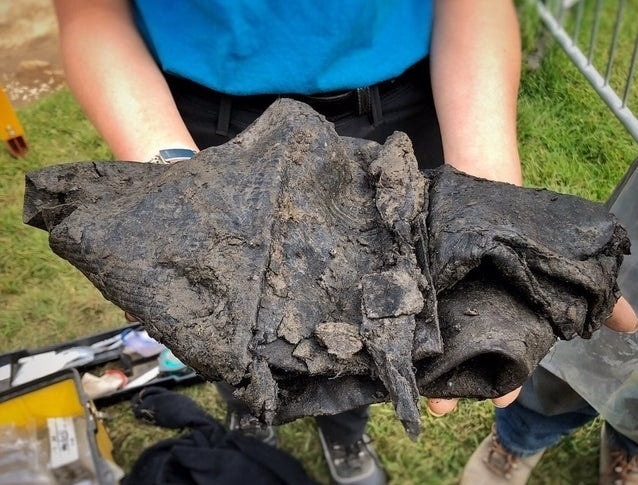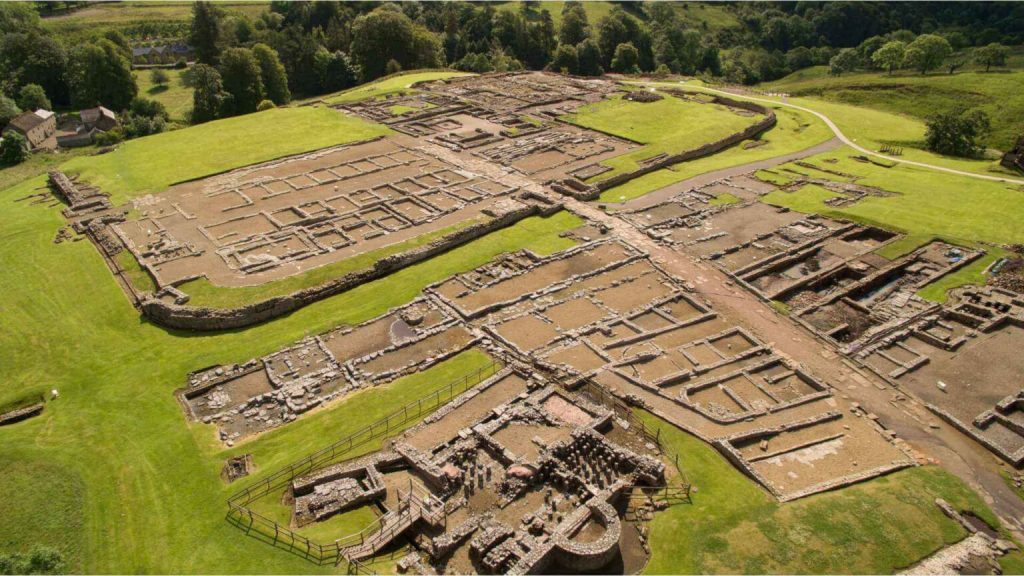In the serene hills of northern England, nestled along the historic Hadrian’s Wall, lies Vindolanda – an ancient Roman fort and settlement that has become a beacon for archaeologists and history enthusiasts alike. This extraordinary site, which thrived for nearly four centuries during Rome’s occupation of Britain, continues to unearth astonishing artifacts that offer a profound glimpse into the lives of Roman soldiers, their families, and local civilians who lived at the empire’s edge.
One of Vindolanda’s most compelling discoveries is a rare and incredibly well-preserved fragment of a Roman tent. Found in the waterlogged soil in 2018, this artifact is a testament to the ingenuity and adaptability of Roman military engineering. Measuring approximately 40 by 30 centimeters, this tent fragment provides an unparalleled look into the material culture and daily life of the Roman soldiers who once guarded this frontier.

The fragment, woven from a blend of sheep’s wool and goat hair, demonstrates the Romans’ advanced textile craftsmanship. Its tight, twill weave and carefully constructed grommets reflect a high level of skill and precision. Even more fascinating, the discovery of traces of a waterproofing agent on the fibers showcases the practical innovations employed by the Roman military to adapt to the unpredictable climate of northern Britain. This small piece of fabric, preserved for nearly two millennia, not only speaks to the technical expertise of the Romans but also underscores their resourcefulness in creating equipment essential for survival and success in distant territories.
However, this artifact is more than just a testament to craftsmanship. It serves as a window into the harsh realities of life on Rome’s northern frontier. The tent fragment, seemingly unused before being packed away, highlights the importance of military readiness and the logistical challenges faced by Roman soldiers. Portable shelters like this tent would have been vital for soldiers enduring long campaigns in a rugged and often unforgiving environment.
The preservation of this fragment is nothing short of miraculous. Unlike many disposable items that deteriorated over time due to use or exposure, this piece was spared from destruction and decay. Its survival offers archaeologists a unique opportunity to study Roman military life with an intimacy that written records alone cannot provide. The artifact’s condition suggests it may have been intentionally stored away, offering a glimpse into the meticulous organization and planning that characterized Roman military operations.
Today, the tent fragment is displayed at Vindolanda’s museum, captivating visitors with its tangible connection to the past. Standing before this extraordinary relic, one can almost imagine the soldiers who once prepared for their campaigns, their lives woven into the fabric of Rome’s history. The artifact serves as a bridge across centuries, linking us to the experiences of those who lived and worked along Hadrian’s Wall.
Further analysis of the tent fragment promises to reveal even more about the soldiers stationed at Vindolanda. Researchers hope to uncover details about the specific units that used such tents, their supply chains, and the broader logistical networks that supported Rome’s occupation of Britain. Every thread of the tent carries a story, offering new insights into the lives of those who contributed to one of history’s greatest empires.
Vindolanda’s archaeological treasures extend beyond the tent fragment. The site has yielded a rich array of artifacts, from writing tablets that record the daily correspondence of Roman soldiers and their families to leather shoes that reveal the fashion and functionality of the time. Together, these finds create a vivid picture of life on the frontier, where Roman culture met local traditions and new identities were forged.
The tent fragment, however, stands out as a symbol of survival, resilience, and ingenuity. It reminds us that history is not only found in grand monuments or epic tales but also in the small, everyday objects that bear witness to human creativity and perseverance. This piece of fabric, carefully crafted and preserved, tells a story of adaptation and innovation that resonates across time.
Vindolanda itself is a testament to the enduring legacy of the Roman Empire. Its strategic location along Hadrian’s Wall underscores the military and administrative importance of this northern outpost. The artifacts unearthed here speak to the complexities of life at the edge of an empire – a life marked by both hardship and ingenuity. As archaeologists continue to excavate and analyze the site, each discovery adds to our understanding of the people who once inhabited this extraordinary place.
For modern visitors, Vindolanda offers a unique opportunity to connect with the past. The museum’s displays and ongoing excavations allow us to step into the shoes of those who lived two thousand years ago. Through artifacts like the tent fragment, we gain a deeper appreciation for the challenges and triumphs of life on the frontier.

This connection to the past is perhaps Vindolanda’s greatest gift. It reminds us that history is not a distant or abstract concept but a living narrative woven from the experiences of countless individuals. The soldiers who once guarded Hadrian’s Wall, the families who supported them, and the local civilians who interacted with them all contributed to a complex and dynamic society that continues to inspire and educate us today.
In the end, the tent fragment represents more than a piece of ancient fabric – it embodies the spirit of discovery and the enduring human desire to understand our shared past. As archaeologists and historians continue to study Vindolanda’s treasures, the stories they uncover will undoubtedly enrich our understanding of the Roman Empire and its impact on the world.
This remarkable artifact, preserved against all odds, serves as a poignant reminder of the ingenuity, resilience, and humanity that have shaped history. It connects us to the lives of those who stood watch along Hadrian’s Wall, offering a tangible link to a distant yet familiar world. In doing so, it invites us to reflect on the timeless themes of survival, adaptation, and the enduring quest to make sense of our place in the world.





